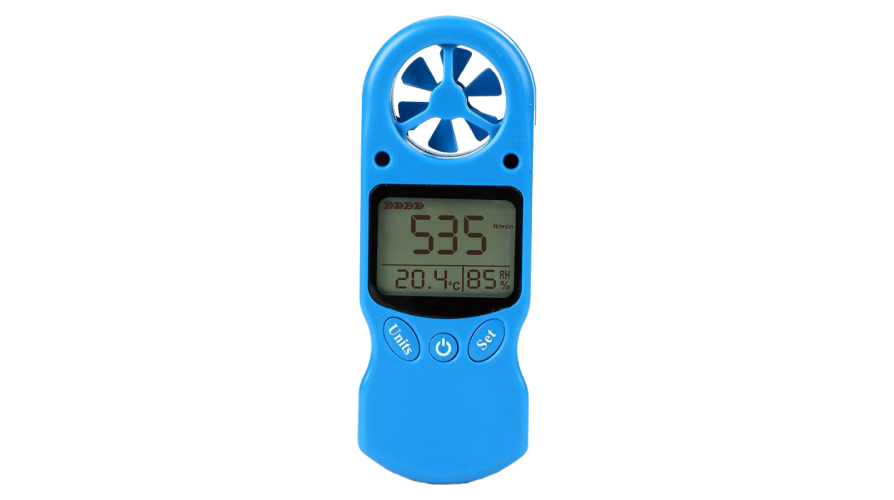How to Maintain and Care for Your Anemometer to Ensure Longevity
How to Maintain and Care for Your Anemometer to Ensure Longevity
Blog Article
All You Need to Understand About Anemometers: Just How They Work, Why They Issue, and Where to Utilize Them
Anemometers, however frequently forgotten in the world of clinical tools, play an essential role in numerous fields, providing valuable insights right into wind speed and air movement patterns. As we dive into the ins and outs of anemometer innovation, we will certainly uncover the internal functions of these tools, their relevance, and the crucial factors to consider when picking the right anemometer for particular applications.

Anemometer Essentials
An essential instrument made use of to gauge wind speed and direction, the anemometer plays a vital function in weather forecasting and various sectors. An anemometer generally is composed of 3 or 4 cups that turn in the wind, a vane that aims into the wind, and sensors to track the turnings or movements. By computing the turnings or motions over a certain amount of time, the anemometer can figure out wind speed. The vane assists figure out wind direction by aiming into the wind, giving valuable data for weather condition forecasting, air travel, maritime procedures, ecological monitoring, and wind energy applications.
There are numerous types of anemometers available, consisting of mug anemometers, vane anemometers, hot-wire anemometers, and sonic anemometers, each with its unique features and applications. Cup anemometers are generally used for basic wind rate measurements, while vane anemometers are favored for directional measurements.
Concepts of Anemometer Procedure
Structure on the fundamental understanding of anemometer fundamentals, the principles of anemometer procedure illuminate the technicians behind wind speed and instructions dimensions. Mug anemometers, for instance, have three or more cups that catch the wind, triggering them to rotate much faster as the wind speed boosts. Hot-wire anemometers count on a heated cable that cools down as wind passes over it, with the rate of cooling determining the wind rate.
Importance of Anemometers
Anemometers play a crucial duty in determining wind rate and direction, supplying necessary data for weather condition projecting, climate researches, environmental monitoring, and aeronautics procedures. Meteorologists rely on anemometers to collect precise wind data, aiding them recognize climate patterns, anticipate storms, and concern timely cautions to the public. Wind ranch drivers make use of anemometers to evaluate wind conditions and take full advantage of power production from wind turbines.
Applications Across Numerous Industries
Applications of anemometers span across diverse markets, showcasing their flexibility and energy beyond meteorology. In the sustainable power view website field, anemometers play a vital function in evaluating wind problems for wind farm placements, guaranteeing optimum power manufacturing. Industries like construction and mining use anemometers to check wind speeds, important for security procedures, especially when operating at elevations or in navigate to this website open-pit mines where solid winds can posture dangers. Anemometers are additionally indispensable in the aeronautics industry, aiding pilots in understanding airspeed and wind instructions for secure take-offs and landings. The maritime sector take advantage of anemometers for ship navigating, assisting sailors anticipate weather modifications and adjust courses accordingly. In agriculture, anemometers help farmers in managing crop spraying by providing real-time information on wind rate to prevent drift. Anemometers locate applications in HVAC systems to enhance air flow and enhance energy effectiveness in buildings. The varied usage situations of anemometers underscore their relevance throughout different industries, highlighting their indispensable function in improving operational safety and effectiveness (anemometer).

Picking the Right Anemometer for Your Requirements
For general functions, a cup anemometer is ideal for measuring wind speed, while a vane anemometer supplies wind instructions data. Hot-wire anemometers are optimal for reduced airspeed dimensions, and ultrasonic anemometers use high precision and resilience.

Verdict
In conclusion, anemometers play an essential function in gauging wind speed and instructions across various industries. It is essential to consider the importance of anemometers in order to make informed decisions when selecting the most suitable tool for determining wind problems.
There are various kinds of anemometers offered, including cup anemometers, vane anemometers, hot-wire anemometers, and sonic anemometers, each with its distinct features and applications. Mug anemometers are generally utilized for standard wind rate measurements, while vane anemometers are preferred for directional dimensions. Hot-wire anemometers are suitable for low airspeeds, and sonic anemometers are excellent for high-precision measurements in research and industrial settings.Building on the foundational understanding of anemometer basics, the principles of anemometer operation elucidate the auto mechanics behind wind speed and direction measurements. For general purposes, a cup anemometer is suitable for determining wind rate, while a vane anemometer provides wind instructions data.
Report this page